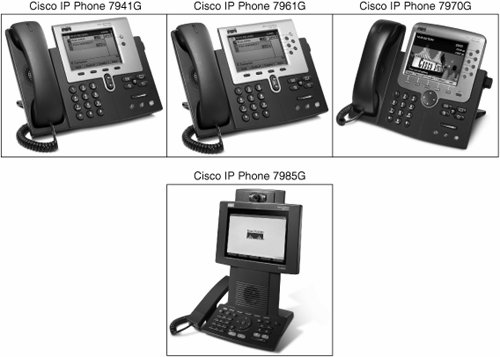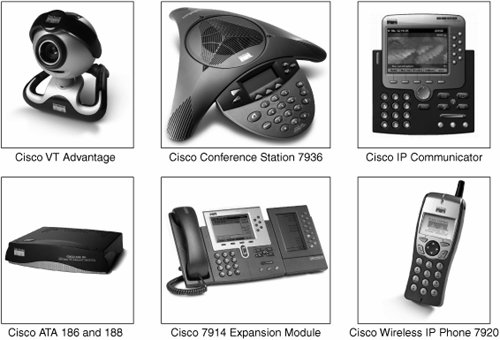Cisco IP Phones
Cisco IP Phones and Other User Devices

|
This chapter covers the following topics:
|
Thus far, you have focused on the Cisco Unified CallManager server as the management system of the Cisco IP telephony network. It is now time to focus on the devices that Cisco CallManager controls. An important task of implementing and supporting an IP telephony deployment is managing the end-user devices, or endpoints. You should be able to distinguish among the various Cisco IP telephony end-user devices that you might encounter during the course of deploying and administering a Cisco IP telephony network.
This chapter explains the various models of Cisco IP Phones and how they work within a Cisco IP telephony solution. You will learn the basic features of Cisco IP Phones, analog adapters, and conference stations; the IP Phone power-up and registration process; and the audio coders-decoders (codecs) that are supported by Cisco IP Phones.
|
To the user, the telephone is the most visible component of the voice communications network. Cisco IP Phones are next-generation, intelligent communication devices that deliver essential business communications. Fully programmable, the growing family of Cisco IP Phones provides the most frequently used business features. The majority of Cisco IP Phones provide the following features:
Each Cisco IP Phone provides toll-quality audio. Because it is an IP-based phone, you can install it in any location on a corporate local or wide-area IP network. Some corporations have even made the Cisco CallManager publicly available on the Internet (with appropriate firewall platforms in place), allowing Cisco IP Phones to register from any location that has an Internet connection. Entry-Level Cisco IP Phones Cisco has produced a number of low-cost, entry-level IP Phones for a variety of business functions. Depending on user requirements, these IP Phones may function well for employees or for use only in public areas, such as lobbies or break rooms. Figure 4-1 shows the four entry-level Cisco IP Phones available at the time of this writing. Figure 4-1. Entry-Level Cisco IP Phones 
Entry-level Cisco phones provide the following common features:
The following list briefly describes the major features of each entry-level Cisco IP Phone:
Note Cisco has positioned the Cisco IP Phone 7912G to replace the Cisco IP Phone 7910G+SW. The Cisco 7910+SW should reach End-of-Life (EOL) in January 2006. Midrange and Upper-End Cisco IP Phones Cisco designed the IP Phones 7940G, 7941G and 7941G-GE, 7960, 7961G and 7961G-GE, 7970G and 7971G-GE, and 7985G to meet the demand for a corporate-level, full-featured IP Phone for medium-to-high telephone use. Figure 4-2 shows the midrange and upper-end Cisco IP Phones available at the time of this writing. Figure 4-2. Midrange and Upper-End Cisco IP Phones 
A description of features that are common to all midrange and upper-end IP Phones follows:
Note The 79XXG-GE IP Phone models offer features identical to the 79XXG models with the exception of the integrated two-port switch. The 79XXG-GE models have integrated, two-port 10/100/1000 switchports, whereas the 79XXG models have integrated, two-port 10/100 switchports. Additional details of these phone models follow:
Tip Cisco has recently upgraded the 7940G and 7960G IP Phones to the 7941G and 7961G. The primary features Cisco added are the support for the IEEE 802.3af PoE standard, higher resolution and backlit display, multiple color line buttons (to support different line states), and advanced XML application support. All other features remain the same. Additional Cisco IP Telephony Endpoints Cisco provides a complete portfolio of IP endpoints to meet business needs for conferencing, wireless voice communications, PC-based voice calls, and connecting analog devices to the VoIP network. Figure 4-3 shows the additional IP telephony endpoints available at the time of this writing. Figure 4-3. Additional IP Telephony Endpoints 
These products are as follows:
Table 4-1 provides a feature-by-feature comparison of the various Cisco IP Phone models. This table comes from "Cisco IP Telephony Solution Reference Network Design (SRND) for Cisco CallManager 4.0 and 4.1" (http://www.cisco.com/en/US/products/sw/voicesw/ps556/products_implementation_design_guide_book09186a00805fdb7b.html) and is printed with permission from Cisco Systems.
|
Part I: Cisco CallManager Fundamentals
Introduction to Cisco Unified Communications and Cisco Unified CallManager
Cisco Unified CallManager Clustering and Deployment Options
- Cisco Unified CallManager Clustering and Deployment Options
- The Two Sides of the Cisco Unified CallManager Cluster
- Cluster Redundancy Designs
- Call-Processing Deployment Models
- Summary
- Review Questions
Cisco Unified CallManager Installation and Upgrades
- Cisco Unified CallManager Installation and Upgrades
- Cisco Unified CallManager 4.x Clean Installation Process
- Upgrading Prior Cisco Unified CallManager Versions
- Summary
- Review Questions
Part II: IPT Devices and Users
Cisco IP Phones and Other User Devices
Configuring Cisco Unified CallManager to Support IP Phones
- Configuring Cisco Unified CallManager to Support IP Phones
- Configuring Intracluster IP Phone Communication
- IP Phone Configuration
- Case Study: Device Pool Design
- Summary
- Review Questions
Cisco IP Telephony Users
- Cisco IP Telephony Users
- Cisco CallManager User Database
- Cisco CallManager User Configuration
- User Logon and Device Configuration
- Summary
- Review Questions
Cisco Bulk Administration Tool
- Cisco Bulk Administration Tool
- The Cisco Bulk Administration Tool
- Using the Tool for Auto-Registered Phone Support
- Summary
- Review Questions
Part III: IPT Network Integration and Route Plan
Cisco Catalyst Switches
- Cisco Catalyst Switches
- Catalyst Switch Role in IP Telephony
- Powering the Cisco IP Phone
- Data and Voice VLANs
- Configuring Class of Service
- Summary
- Review Questions
Configuring Cisco Gateways and Trunks
- Configuring Cisco Gateways and Trunks
- Cisco Gateway Concepts
- Configuring Access Gateways
- Cisco Trunk Concepts
- Configuring Intercluster Trunks
- SIP and Cisco CallManager
- Summary
- Review Questions
Cisco Unified CallManager Route Plan Basics
- Cisco Unified CallManager Route Plan Basics
- External Call Routing
- Route Plan Configuration Process
- Summary
- Review Questions
Cisco Unified CallManager Advanced Route Plans
- Cisco Unified CallManager Advanced Route Plans
- Route Filters
- Discard Digit Instructions
- Transformation Masks
- Translation Patterns
- Route Plan Report
- Summary
- Review Questions
Configuring Hunt Groups and Call Coverage
- Configuring Hunt Groups and Call Coverage
- Call Distribution Components
- Configuring Line Groups, Hunt Lists, and Hunt Pilots
- Summary
- Review Questions
Implementing Telephony Call Restrictions and Control
- Implementing Telephony Call Restrictions and Control
- Class of Service Overview
- Partitions and Calling Search Spaces Overview
- Time-of-Day Routing Overview
- Configuring Time-of-Day Routing
- Time-of-Day Routing Usage Scenario
- Summary
- Review Questions
Implementing Multiple-Site Deployments
- Implementing Multiple-Site Deployments
- Call Admission Control
- Survivable Remote Site Telephony
- Summary
- Review Questions
Part IV: VoIP Features
Media Resources
- Media Resources
- Introduction to Media Resources
- Conference Bridge Resources
- Media Termination Point Resources
- Annunciator Resources
- Transcoder Resources
- Music on Hold Resources
- Media Resource Management
- Summary
- Review Questions
Configuring User Features, Part 1
- Configuring User Features, Part 1
- Basic IP Phone Features
- Softkey Templates
- Enhanced IP Phone Features
- Barge and Privacy
- IP Phone Services
- Summary
- Review Questions
Configuring User Features, Part 2
- Configuring User Features, Part 2
- Cisco CallManager Extension Mobility
- Client Matter Codes and Forced Authentication Codes
- Call Display Restrictions
- Malicious Call Identification
- Multilevel Precedence and Preemption
- Summary
- Review Questions
Configuring Cisco Unified CallManager Attendant Console
- Configuring Cisco Unified CallManager Attendant Console
- Introduction to Cisco CallManager Attendant Console
- Call Routing and Call Queuing
- Server and Administration Configuration
- Cisco Attendant Console Features
- Summary
- Review Questions
Configuring Cisco IP Manager Assistant
- Configuring Cisco IP Manager Assistant
- Cisco IP Manager Assistant Overview
- Cisco IP Manager Assistant Architecture
- Configuring Cisco IPMA for Shared-Line Support
- Summary
- Review Questions
Part V: IPT Security
Securing the Windows Operating System
- Securing the Windows Operating System
- Threats Targeting the Operating System
- Security and Hot Fix Policy
- Operating System Hardening
- Antivirus Protection
- Cisco Security Agent
- Administrator Password Policy
- Common Windows Exploits
- Security Taboos
- Summary
- Review Questions
Securing Cisco Unified CallManager Administration
- Securing Cisco Unified CallManager Administration
- Threats Targeting Remote Administration
- Securing CallManager Communications Using HTTPS
- Multilevel Administration
- Summary
- Review Questions
Preventing Toll Fraud
- Preventing Toll Fraud
- Toll Fraud Exploits
- Preventing Call Forward and Voice-Mail Toll Fraud Using Calling Search Spaces
- Blocking Commonly Exploited Area Codes
- Using Time-of-Day Routing
- Using FAC and CMC
- Restricting External Transfers
- Dropping Conference Calls
- Summary
- Review Questions
Hardening the IP Phone
Understanding Cryptographic Fundamentals
- Understanding Cryptographic Fundamentals
- What Is Cryptography?
- Symmetric Encryption
- Asymmetric Encryption
- Hash Functions
- Digital Signatures
- Summary
- Review Questions
Understanding the Public Key Infrastructure
- Understanding the Public Key Infrastructure
- The Need for a PKI
- PKI as a Trusted Third-Party Protocol
- PKI Entities
- PKI Enrollment
- PKI Revocation and Key Storage
- PKI Example
- Summary
- Review Questions
Understanding Cisco IP Telephony Authentication and Encryption Fundamentals
- Understanding Cisco IP Telephony Authentication and Encryption Fundamentals
- Threats Targeting the IP Telephony System
- How CallManager Protects Against Threats
- PKI Topologies in Cisco IP Telephony
- PKI Enrollment in Cisco IP Telephony
- Keys and Certificate Storage in Cisco IP Telephony
- Authentication and Integrity
- Encryption
- Summary
- Review Questions
Configuring Cisco IP Telephony Authentication and Encryption
- Configuring Cisco IP Telephony Authentication and Encryption
- Authentication and Encryption Configuration Overview
- Enabling Services Required for Security
- Using the CTL Client
- Working with Locally Significant Certificates
- Configuring the Device Security Mode
- Negotiating Device Security Mode
- Generating a CAPF Report
- Summary
- Review Questions
Part VI: IP Video
Introducing IP Video Telephony
- Introducing IP Video Telephony
- IP Video Telephony Solution Components
- Video Call Concepts
- Video Protocols Supported in Cisco CallManager
- Bandwidth Management
- Call Admission Control Within a Cluster
- Call Admission Control Between Clusters
- Summary
- Review Questions
Configuring Cisco VT Advantage
- Configuring Cisco VT Advantage
- Cisco VT Advantage Overview
- How Calls Work with Cisco VT Advantage
- Configuring Cisco CallManager for Video
- Configuring Cisco IP Phones for Cisco VT Advantage
- Installing Cisco VT Advantage on a Client
- Summary
- Review Questions
Part VII: IPT Management
Introducing Database Tools and Cisco Unified CallManager Serviceability
- Introducing Database Tools and Cisco Unified CallManager Serviceability
- Database Management Tools
- Cisco CallManager Serviceability Overview
- Tools Overview
- Summary
- Review Questions
Monitoring Performance
- Monitoring Performance
- Performance Counters
- Microsoft Event Viewer
- Microsoft Performance Monitor
- Real-Time Monitoring Tool Overview
- Summary
- Review Questions
Configuring Alarms and Traces
- Configuring Alarms and Traces
- Alarm Overview
- Alarm Configuration
- Trace Configuration
- Trace Analysis
- Trace Collection
- Bulk Trace Analysis
- Additional Trace Tools
- Summary
- Review Questions
Configuring CAR
- Configuring CAR
- CAR Overview
- CAR Configuration
- Report Scheduling
- System Database Configuration
- User Report Configuration
- Summary
- Review Questions
Using Additional Management and Monitoring Tools
- Using Additional Management and Monitoring Tools
- Remote Management Tools
- Dependency Records
- Password Changer Tool
- Cisco Dialed Number Analyzer
- Quality Report Tool
- Summary
- Review Questions
Part VIII: Appendix
Appendix A. Answers to Review Questions
Index
EAN: 2147483647
Pages: 329
- Article 300: Wiring Methods
- Article 360 Flexible Metallic Tubing Type FMT
- Example D3(a) Industrial Feeders in a Common Raceway
- Example No. D4(b) Optional Calculation for Multifamily Dwelling
- Example No. D10 Feeder Ampacity Determination for Adjustable-Speed Drive Control [See 215.2, 430.24, 620.13, 620.14, 620.61, Tables 430.22(E), and 620.14]
